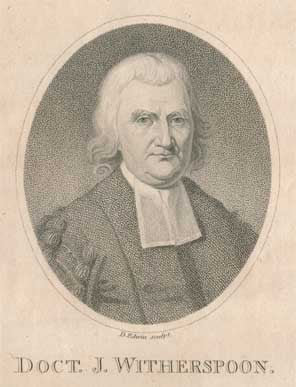This Day in Presbyterian History:
A Colossal Monument for a Spiritual Giant
 Standing twenty feet tall and weighing thousands of pounds, and located in the nation’s second-largest city park (Fairmount Park, in Philadelphia, comprises 4,618 acres), the colossal monument to the Rev. Jonathan Witherspoon is a monument to Presbyterianism. Erected on the centennial of our nation on October 20, 1876, it is a beautiful work of art, as the New York Times article described it.
Standing twenty feet tall and weighing thousands of pounds, and located in the nation’s second-largest city park (Fairmount Park, in Philadelphia, comprises 4,618 acres), the colossal monument to the Rev. Jonathan Witherspoon is a monument to Presbyterianism. Erected on the centennial of our nation on October 20, 1876, it is a beautiful work of art, as the New York Times article described it.
On the North side of the monument is a quotation from John Witherspoon. It states, “For my own part, of prospectus I have some, of reputation more; that reputation is staked, that property is pledged on the issue of this contest. And although these gray hairs must soon descend into the sepulchre, I would infinitely rather that should descend thither by the hand of the executioner than desert at this crisis the sacred cause of my country.”
The south side of the monument is the quotation from Leviticus 20:10 which is found on the Liberty Bell at Independence Hall in Philadelphia. It says “proclaim liberty throughout all the land unto all the inhabitants thereof.”
The east side reads: “John Witherspoon, D.D., LL.D; a lineal descendant of John Knox; born in Scotland; February 5, 1722; ordained minister in the Presbyterian Church 1745; President of the College of New Jersey, 1768–94; the only clergyman in the Continental Congress; a signer of the Declaration of Independence; died at Princeton, NJ November 15, 1794”
The west side states that “this statue erected under the authority of a committee appointed by the General Assembly of the Presbyterian Church of the United States of America, July 4, 1876.”
On the bottom is the brief statement that “this pedestal is the gift of the Presbyterians in Philadelphia and vicinity.”
Its unveiling was done by D.W. Woods, Esq., a grandson of John Witherspoon, plus various ministers, the governor of New Jersey, and a representative of Princeton Theological Seminary.
Words to live by: We remember the first act of Joshua upon crossing the Jordan River was to take twelve rocks from that water barrier and set them up on the bank. He wanted a glorious report to the second generation about the Lord’s person and power in accomplishing the entrance into the promised land. This was similar to the monument to John Witherspoon. It placed the focus upon the God of providence in bringing this spiritual giant to America for such a time as then, to train ministers for the nation and a nation for the people. God continues to work His wonders today in church and state. Recognize them, and praise God for them.
Through the Scriptures: Mathew 20 – 22
Through the Standards: Benefits of communion with Christ in glory
WLC 82 — “What is the communion in glory which the members of the invisible church have with Christ?
A. The communion in glory which the members of the invisible church have with Christ, is in this life, immediately after death, and at last perfected at the resurrection and day of judgment.”
Image source : Frontispiece portrait, facing the title page in Vol. I of The General Assembly’s Missionary Magazine; or, Evangelical Intelligencer. Philadelphia: William P. Farrand, 1806.
Tags: Fairmount Park, John Witherspoon, New Jersey, Presbyterian Church

No comments
Comments feed for this article